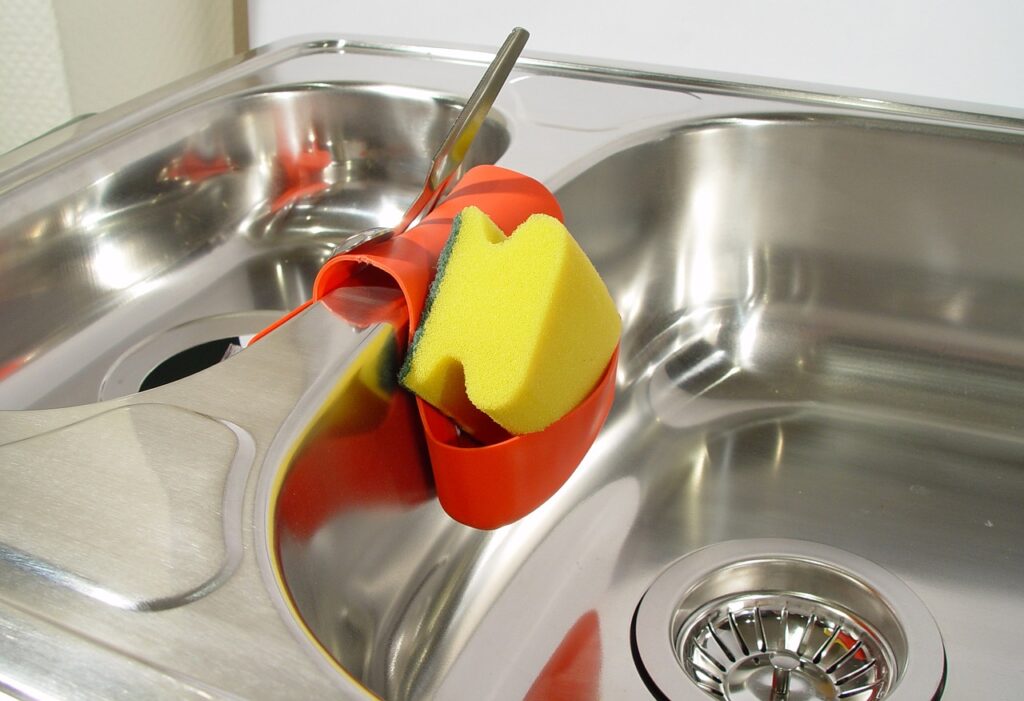
No matter how careful you are, your kitchen sink will still have scratches over time due to wear and tear. It can be caused by various factors including washing your pots and pans and coarse materials used for cleaning. These scratches can look ugly and unfortunately, they may not be easily erased. Hence, it makes sense to know how to protect your kitchen sink from scratches and lengthen its lifespan.
NB: This post contains affiliate links which will enable us to earn some commission if you click and buy.
Identify The Causes

The first step is to learn what could create scratches on your sink and then think of ways to minimize the risk. Kitchen sinks are made of different materials from stainless steel to granite. Hence, the level of care and susceptibility to scratches will also differ. If you are investing in a new kitchen sink, then you should take the time to learn more about the different materials. All of them have their own pros and cons.
But generally, using abrasive materials to clean your sink is a big no. For instance, harsh chemicals or coarse cleaning pads like steel wool should best be avoided. This is because these materials can wear away the surface of your sink. This will then expose it to scratches and other damage. Therefore, opt for more gentle cleaners and use a cloth or sponge instead of a scrubbing pad to clean your kitchen sink.
Another common cause of kitchen sink scratches is simply dropping heavy objects like pots and pans onto the sink. Sharp cooking tools such as knives and scissors can also be the culprit. Sometimes, these items can just slip out of our hands during washing as they can be slippery. Furthermore, if you have limited space to dry your dishes and need to stack them up across the sink, some items may just fall into it and scratch the surface.
If that is the case, what can you put in a kitchen sink to prevent scratches then?
Sink Mat To Prevent Kitchen Sink From Scratches

A kitchen sink protector is also known as a sink mat or grid. It comes in a variety of shapes and sizes to fit different sink measurements. It is designed to be laid over the bottom of your sink to keep it from scratches. This way, all the items that you need to wash will be placed on top of the kitchen sink mat or grate rather than in direct contact with the sink surface itself. With this barrier, there will be minimal chance for scratches to develop at the bottom of your sink.
These sink protectors are typically made of stainless steel and silicone. Apart from preventing scratches, they are also useful in catching any food scraps or debris. Some will also work well as a dish drying and cooling rack. With high temperature resistance, you can transfer your pot or pan to the mat right from the stove. Thus, they are a multi-purpose item which is great for any kitchen.
When choosing a sink protector, be sure to select one that fits your sink properly. You will need to measure the bottom of your sink to make sure that it fits. Don’t measure the top because some sinks may slope towards the bottom. Therefore, if you buy the kitchen sink protector based on the top measurement, it may not be able to fit the smaller bottom.
Protecting The Sides For Double Sink

If you have a double sink for your kitchen, you may also want to protect the 2 sides that are next to each other. You can get a sink saddle for this purpose. They are mainly made of silicone and flexible. There will be suction cups at the back to keep the saddle in place.
Apart from protecting the kitchen sink from scratches, a sink saddle is also useful in preventing damage and chipping to your glasses and plates. With the soft padding, items are less likely to crack and chip when you hit them against the side of the sink. After all, this is a common occurrence during washing or transferring from one side to another.
How to prevent your kitchen sink from scratches as shown above is to help you maintain its appearance and cleanliness. Just like how you would stop water from going behind the sink and around the faucet to stop mold from growing, the goal is not to let it turn unsightly and unhygienic. It may require some investment but you would have a cleaner and better-looking kitchen as a result.
Leave a Reply